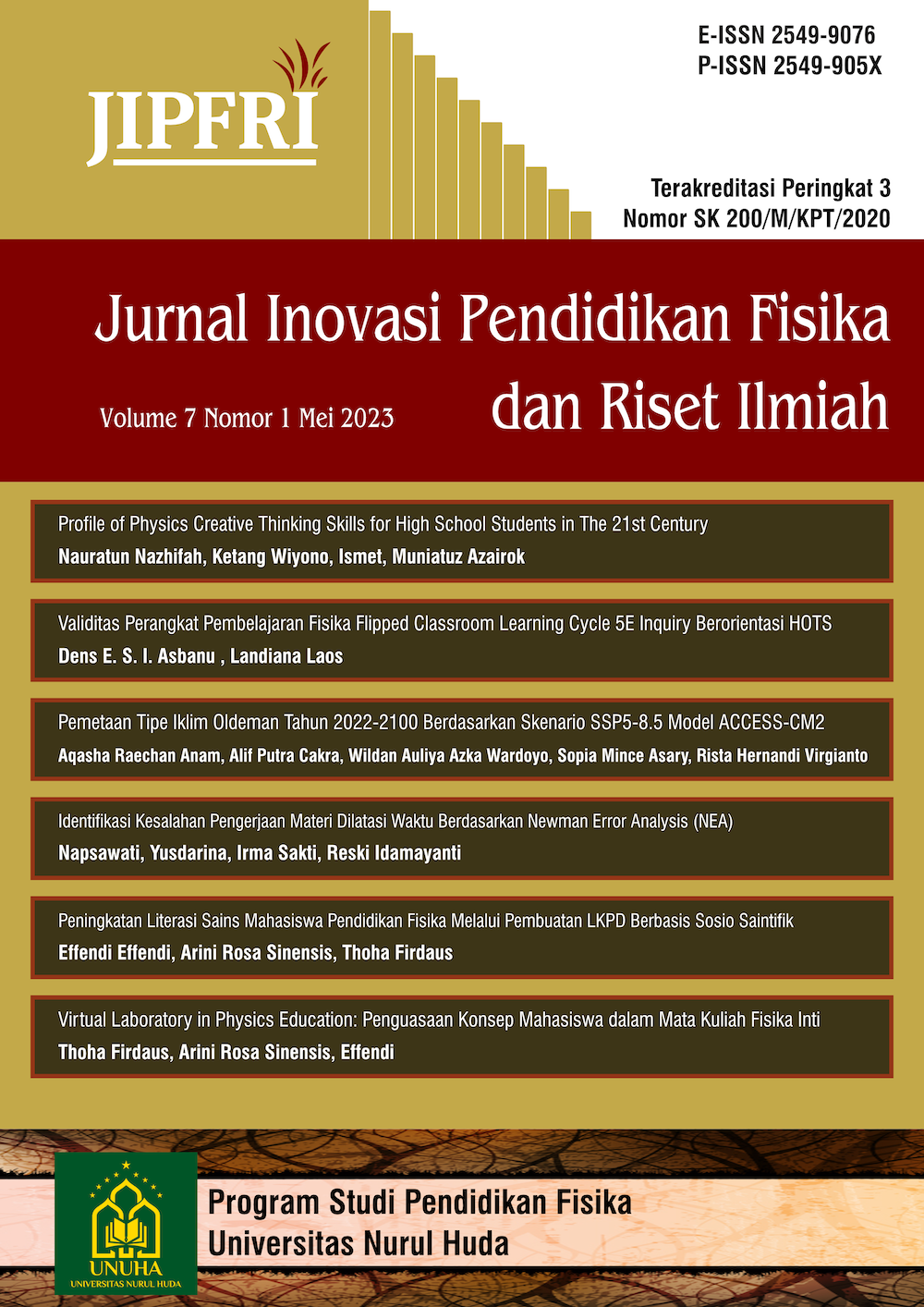Pemetaan Tipe Iklim Oldeman Tahun 2022-2100 Berdasarkan Skenario SSP5-8.5 Model ACCESS-CM2
DOI:
https://doi.org/10.30599/jipfri.v7i1.2046Keywords:
Oldeman Classification, Climate Change,, Scenarios, ProjectionsAbstract
Climate change is part of the most serious problem for the life of the world community today. One sector that is highly vulnerable to the impacts of climate change is the agricultural sector. One method that can be used is to see a picture of the future climate by making climate projections based on certain scenarios. The data used in this study are monthly rainfall data at 4 observation points of BMKG stations as well as Historical and Projection model data from the SSP5-8.5 ACCES-CM2 model scenario at 36 points in the West Java region taken from Copernicus ECMWF at https://cds.climate.copernicus.eu/. The results showed that a comparison of Oldeman's classification based on the 2 projection data used showed differences, namely for SSP2-4.5 data it was more categorical in class D while for SSP5-8.5 data the classification was in class C except for the period 2071-2100 for SSP2-4.5 data showing classification in class B. It can be said that in the West Java region rice can be planted once based on SSP2-4.5 data and twice based on SSP5-8.5 data.
Downloads
References
Fauziyah, A. R., Safril, A., & Ali, M. (2015). Proyeksi Kesesuaian Agroklimat Tanaman Padi Berdasarkan Skenario Representative Concentration Pathways (RCP) 4.5 di Provinsi Jawa Tengah. Jurnal Meteorologi Dan Geofisika, 4(3).
Kusumo, I., & Septiadi, D. (2016). Tipe Iklim Oldeman 2011-2100 Berdasarkan Skenario RCP 4.5 dan RCP 8.5 di Wilayah Sumatera Selatan. Jurnal Meteorologi Klimatologi Dan Geofisika, 3(3), 26–36.
Prabaningrum, R., & Nuriani, E. (2016). Identifikasi perubahan zona agroklimat metode oldeman Di Provinsi Jawa Barat. Bumi Indonesia, 5(4), 1–10.
Ulfi, H. T., Khusrizal, K., & Rusdi, M. (2018). Distribusi Tipe Iklim Oldeman dan Proyeksinya Berdasarkan RCP 4.5 di Kabupaten Aceh Utara. Jurnal Agrium, 15(2). https://doi.org/10.29103/agrium.v15i2.5865
BKD. (2022). Geografi Dan Topografi Jawa Barat. BKD Jabar.
BPS. (2021, October 30). Luas daerah Jawa Barat. BPS Jabar.
IPCC. (2014). Fifth Assesment Report. Summary for Policy Makers. Climate Change 2014: Impacts, Adaptation and Vulnerability - Contributions of the Working Group II to the Fifth Assessment Report.
Juswadi, J. (2021). Pengaruh Produksi Sektor Pertanian Terhadap Produksi Subsektor Industri Pertanian Provinsi Jawa Barat. Agri Wiralodra, 13(1). https://doi.org/10.31943/agriwiralodra.v13i1.16
Marsitha Barung, F., & Suwandi, S. (2019). Proyeksi Kesesuaian Agroklimat Tanaman Padi Berdasarkan Skenario Representative Concentration Pathways (Rcp)4.5 Dan Rcp8.5 Di Provinsi Jawa Timur. Jurnal Meteorologi Klimatologi Dan Geofisika, 4(3). https://doi.org/10.36754/jmkg.v4i3.51
Masturi, H., Hasanawi, A., & Hasanawi, A. (2021). Sinergi Dalam Pertanian Indonesia untuk Mitigasi dan Adaptasi Perubahan Iklim. Jurnal Inovasi Penelitian, 1(10).
Misnawati, Boer, R., June, T., & Faqih, A. (2018). Perbandingan Metodologi Koreksi Bias Data Curah Hujan CHIRPS. LIMNOTEK - Perairan Darat Tropis Di Indonesia, 25(1).
Oldeman, L. R., Hakkeling, R. T. A., & Sombroek, W. . G. (2007). World map of the status of human-induced soil degradation: an explanatory note. In International Soil Reference And Information Centre (Vol. 18, Issue 3).
Purnomo, H. (2018). Aplikasi Metode Interpolasi Inverse Distance Weighting Dalam Penaksiran Sumberdaya Laterit Nikel (Studi kasus di Blok R, Kabupaten Konawe-Sulawesi Tenggara). Angkasa: Jurnal Ilmiah Bidang Teknologi, 10(1). https://doi.org/10.28989/angkasa.v10i1.221
Surmaini, E., & Faqih, A. (2016). Kejadian Iklim Ekstrem Dan Dampaknya Terhadap Pertanian Tanaman Pangan Di Indonesia. Jurnal Sumberdaya Lahan, 10(2).
Tebaldi, C., Debeire, K., Eyring, V., Fischer, E., Fyfe, J., Friedlingstein, P., Knutti, R., Lowe, J., O’Neill, B., Sanderson, B., van Vuuren, D., Riahi, K., Meinshausen, M., Nicholls, Z., Tokarska, K., Hurtt, G., Kriegler, E., Meehl, G., Moss, R., … Ziehn, T. (2021). Climate model projections from the Scenario Model Intercomparison Project (ScenarioMIP) of CMIP6. Earth System Dynamics, 12(1). https://doi.org/10.5194/esd-12-253-2021
World Meteorological Organization (WMO). (2020). WMO Statement on the Status of the Global Climate in 2019. In World Meteorological Organization (Issue 1248).
Wredaningrum, I., & Sudibyakto. (2014). Analisis Perubahan Zona Agroklimat Daerah Istimewa Yogyakarta Ditinjau Dari Klasifikasi Iklim Menurut Oldeman. Jurnal Bumi Indonesia, 2(5).
Downloads
Published
How to Cite
Issue
Section
License
Copyright (c) 2023 Aqasha Raechan Anam, Alif Putra Cakra, Wildan Auliya Azka Wardoyo, Sopia Mince Asary, Rista Hernandi Virgianto

This work is licensed under a Creative Commons Attribution-ShareAlike 4.0 International License.










